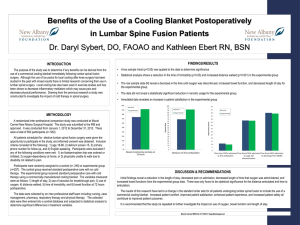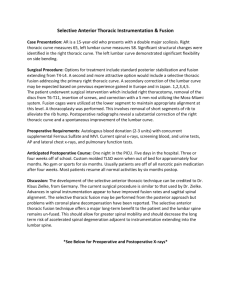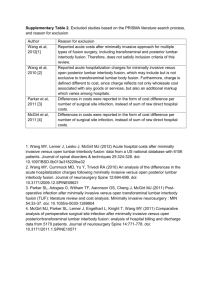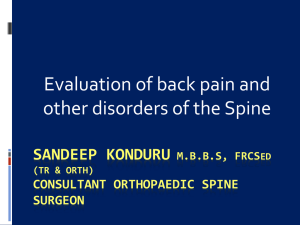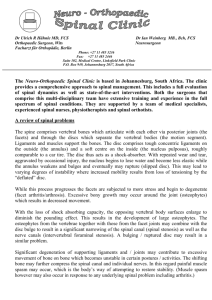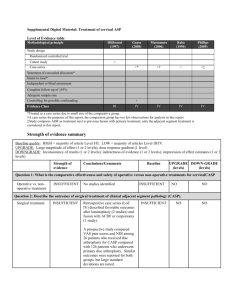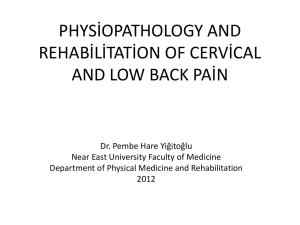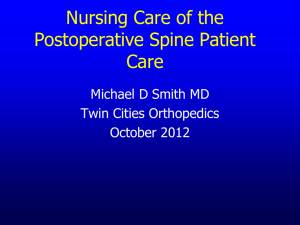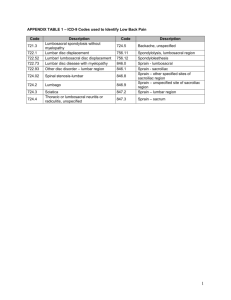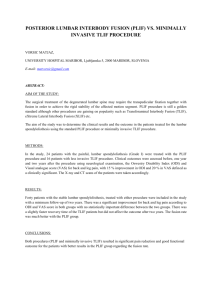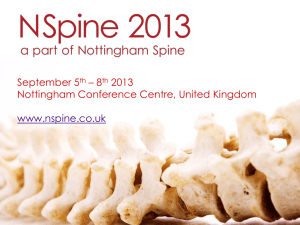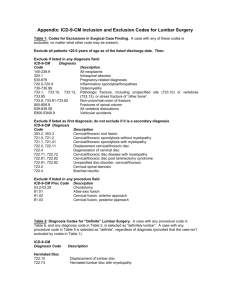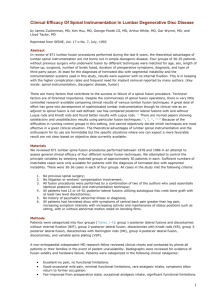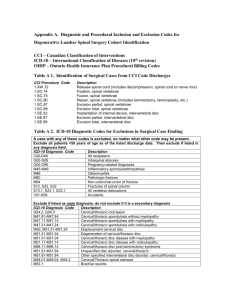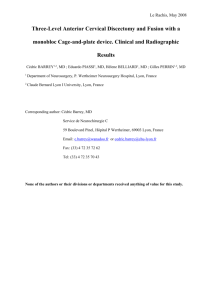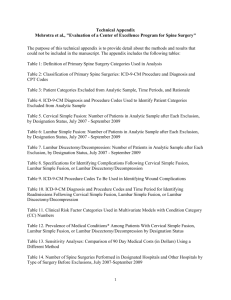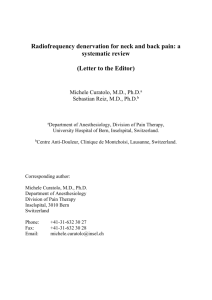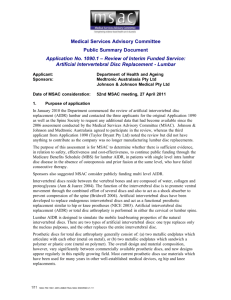Postoperative Hospitalization Time After Spinal Surgery
advertisement
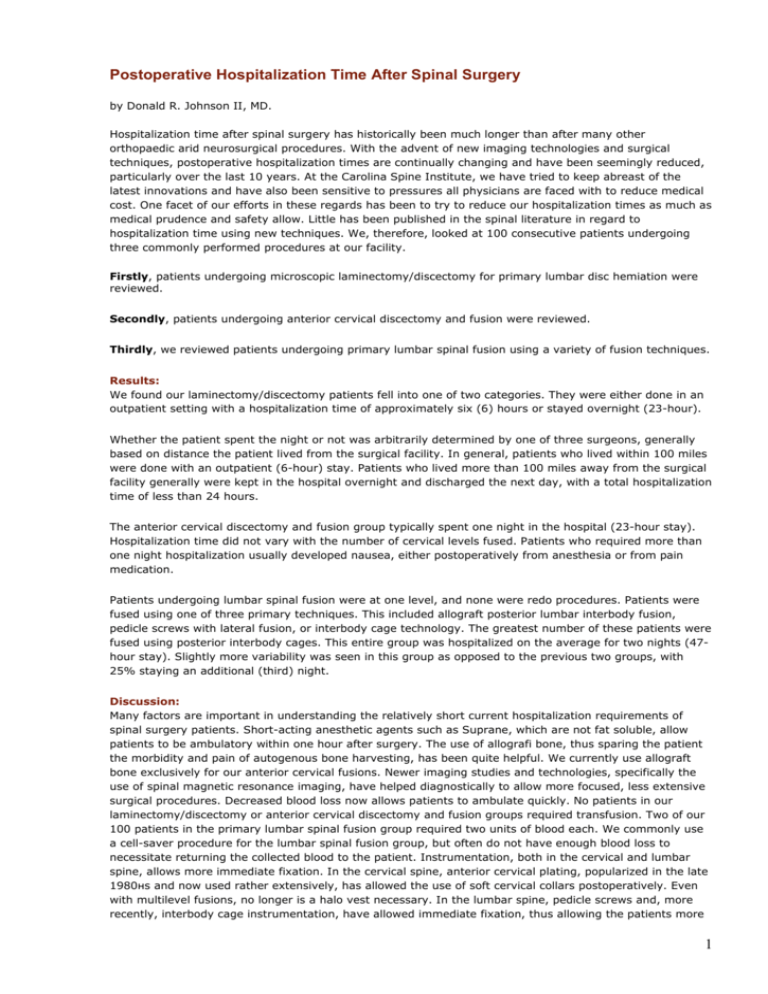
Postoperative Hospitalization Time After Spinal Surgery by Donald R. Johnson II, MD. Hospitalization time after spinal surgery has historically been much longer than after many other orthopaedic arid neurosurgical procedures. With the advent of new imaging technologies and surgical techniques, postoperative hospitalization times are continually changing and have been seemingly reduced, particularly over the last 10 years. At the Carolina Spine Institute, we have tried to keep abreast of the latest innovations and have also been sensitive to pressures all physicians are faced with to reduce medical cost. One facet of our efforts in these regards has been to try to reduce our hospitalization times as much as medical prudence and safety allow. Little has been published in the spinal literature in regard to hospitalization time using new techniques. We, therefore, looked at 100 consecutive patients undergoing three commonly performed procedures at our facility. Firstly, patients undergoing microscopic laminectomy/discectomy for primary lumbar disc hemiation were reviewed. Secondly, patients undergoing anterior cervical discectomy and fusion were reviewed. Thirdly, we reviewed patients undergoing primary lumbar spinal fusion using a variety of fusion techniques. Results: We found our laminectomy/discectomy patients fell into one of two categories. They were either done in an outpatient setting with a hospitalization time of approximately six (6) hours or stayed overnight (23-hour). Whether the patient spent the night or not was arbitrarily determined by one of three surgeons, generally based on distance the patient lived from the surgical facility. In general, patients who lived within 100 miles were done with an outpatient (6-hour) stay. Patients who lived more than 100 miles away from the surgical facility generally were kept in the hospital overnight and discharged the next day, with a total hospitalization time of less than 24 hours. The anterior cervical discectomy and fusion group typically spent one night in the hospital (23-hour stay). Hospitalization time did not vary with the number of cervical levels fused. Patients who required more than one night hospitalization usually developed nausea, either postoperatively from anesthesia or from pain medication. Patients undergoing lumbar spinal fusion were at one level, and none were redo procedures. Patients were fused using one of three primary techniques. This included allograft posterior lumbar interbody fusion, pedicle screws with lateral fusion, or interbody cage technology. The greatest number of these patients were fused using posterior interbody cages. This entire group was hospitalized on the average for two nights (47hour stay). Slightly more variability was seen in this group as opposed to the previous two groups, with 25% staying an additional (third) night. Discussion: Many factors are important in understanding the relatively short current hospitalization requirements of spinal surgery patients. Short-acting anesthetic agents such as Suprane, which are not fat soluble, allow patients to be ambulatory within one hour after surgery. The use of allografi bone, thus sparing the patient the morbidity and pain of autogenous bone harvesting, has been quite helpful. We currently use allograft bone exclusively for our anterior cervical fusions. Newer imaging studies and technologies, specifically the use of spinal magnetic resonance imaging, have helped diagnostically to allow more focused, less extensive surgical procedures. Decreased blood loss now allows patients to ambulate quickly. No patients in our laminectomy/discectomy or anterior cervical discectomy and fusion groups required transfusion. Two of our 100 patients in the primary lumbar spinal fusion group required two units of blood each. We commonly use a cell-saver procedure for the lumbar spinal fusion group, but often do not have enough blood loss to necessitate returning the collected blood to the patient. Instrumentation, both in the cervical and lumbar spine, allows more immediate fixation. In the cervical spine, anterior cervical plating, popularized in the late 1980нs and now used rather extensively, has allowed the use of soft cervical collars postoperatively. Even with multilevel fusions, no longer is a halo vest necessary. In the lumbar spine, pedicle screws and, more recently, interbody cage instrumentation, have allowed immediate fixation, thus allowing the patients more 1 comfort for early ambulation. Postoperative pain control is an especially important component of allowing early ambulation and discharge. We have found the postoperative patient-controlled analgesia to be quite useful, particularly in our fusion group patients. This, and immediate icing of the surgical wound, allows the patient to quickly control postoperative discomfort, thus making him more able to be ambulatory. Immediate postoperative instruction and help with physical therapy have been also important to the timely discharge of our patients. Trained physical therapists visit our hospitalized patients twice per day, after breakfast and after lunch, and require the patient to be ambulatory 500 feet in the hail, as well as up and down two flights of stairs, before they are released from therapy, ready for hospital discharge. Also, pre- and postoperative education by physical therapy has been quite helpful. Most importantly, we believe that the expectation set by the physician office staff and hospital staff may be the single most important factor for reducing hospitalization stay. We found that most patients make every effort to be ambulatory and in line with what is expected of them after surgery, if this is stressed to them by every medical staff personnel who interacts with them from the time that surgery has been agreed upon by the patient and surgeon. Conclusion: Our review shows that hospitalization times after spinal surgery can be relatively short and hopefully will lead to quicker rehabilitation times and reduced medical cost. 2
